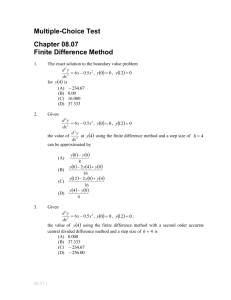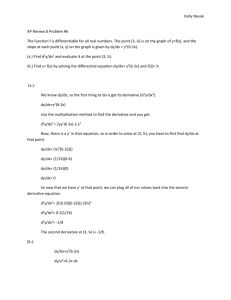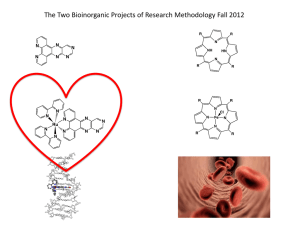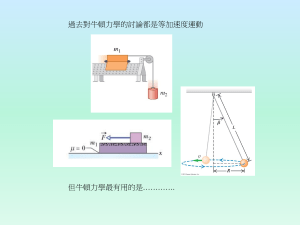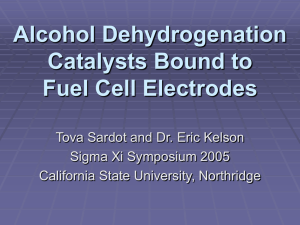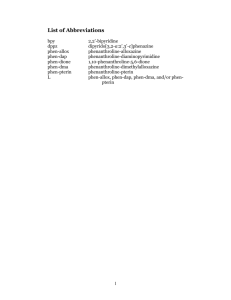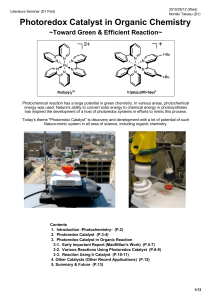H2-5-(4-nitrophenyl)-10,15,20
advertisement
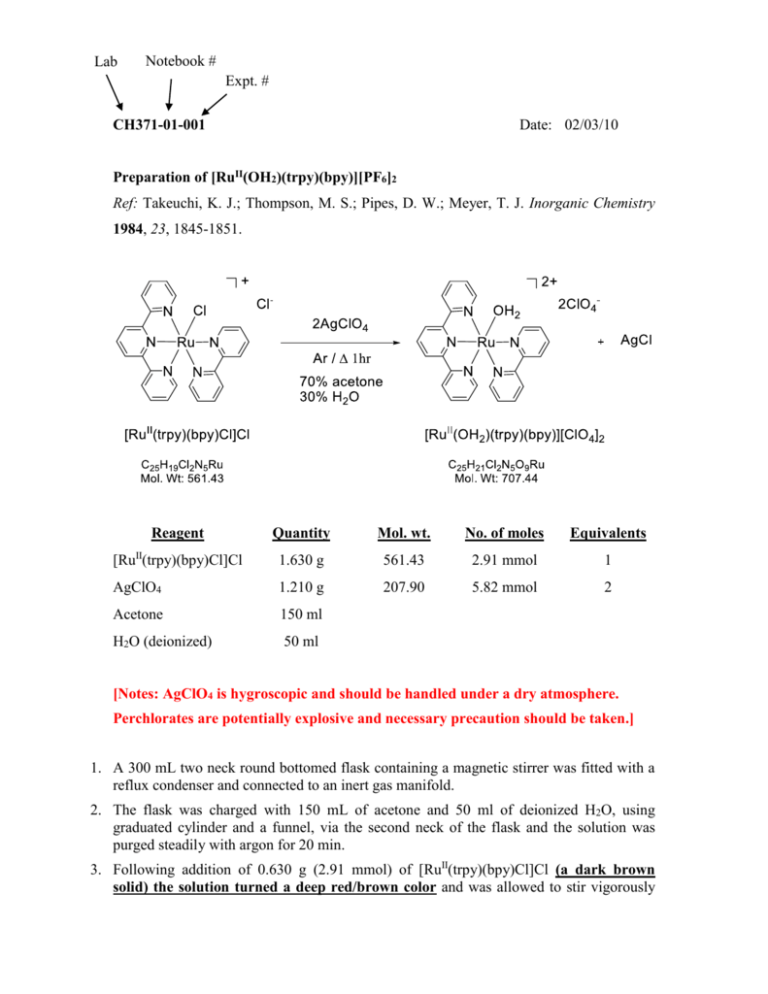
Lab Notebook # Expt. # CH371-01-001 Date: 02/03/10 Preparation of [RuII(OH2)(trpy)(bpy)][PF6]2 Ref: Takeuchi, K. J.; Thompson, M. S.; Pipes, D. W.; Meyer, T. J. Inorganic Chemistry 1984, 23, 1845-1851. Reagent Quantity Mol. wt. No. of moles Equivalents [RuII(trpy)(bpy)Cl]Cl 1.630 g 561.43 2.91 mmol 1 AgClO4 1.210 g 207.90 5.82 mmol 2 Acetone 150 ml H2O (deionized) 50 ml [Notes: AgClO4 is hygroscopic and should be handled under a dry atmosphere. Perchlorates are potentially explosive and necessary precaution should be taken.] 1. A 300 mL two neck round bottomed flask containing a magnetic stirrer was fitted with a reflux condenser and connected to an inert gas manifold. 2. The flask was charged with 150 mL of acetone and 50 ml of deionized H2O, using graduated cylinder and a funnel, via the second neck of the flask and the solution was purged steadily with argon for 20 min. 3. Following addition of 0.630 g (2.91 mmol) of [RuII(trpy)(bpy)Cl]Cl (a dark brown solid) the solution turned a deep red/brown color and was allowed to stir vigorously for 10 min to allow complete dissolution of the complex reagent while maintaining an argon atmosphere. 4. In the meantime 1.210 g (5.82 mmol) of AgClO4 was weighted out into a sample vial in a dry box. 5. Following complete dissolution of [RuII(trpy)(bpy)Cl]Cl the pre-weighed AgClO4 sample was directly added to the reaction mixture, while maintaining an argon atmosphere. Obs: The solution immediately became darker in color. 6. The reaction vessel was then sealed with a glass stopper, maintaining a positive argon flow via the inert gas manifold and the solution heated using an electromantle to reflux temperature (ca. ~ 90°C ?). 7. Once reflux was observed the reaction was continued for 1 hour at which time the heat was removed but stirring was continued. Obs: No color change was evident during the course of the reflux. A dark precipitate developed over time. 8. Upon cooling the reaction mixture was subjected to vacuum filtration through a fine glass frit to remove the dark AgCl precipitate. Filtration was repeated 3 times to ensure complete removal. 9. The deep brown filtrate (150 ml) was reduced to roughly 35 ml on a rotary evaporator. 10. The remaining solution was poured into a 100 ml Erlenmyer flask and allowed to reach room temperature. 11. The Erlenmeyer flask was stoppered and the solution sat in the fridge overnight resulting in the precipitation of dark brown needles. The product was isolated by Buchner filtration on a fine glass frit, washed with ice cold deionized water, allowed to air dry. The yield was recorded in a pre-weighed vial and the sample stored under argon. [Caution was taken here not to scratch the spatula against the perchlorate salt on the glass frit – potentially explosive!!] Theoretical Yield of [RuII(OH2)(trpy)(bpy)][ClO4]2 = (707.44 gmol-1)(2.91 x 10-3 mol) = 2.06 g Expt. Yield of [RuII(OH2)(trpy)(bpy)][ClO4]2 = 1.85 g (2.62 mmol) % Yield of [RuII(OH2)(trpy)(bpy)][ClO4]2 = (1.85 g / 2.06g)(100/1) = 90 % yield
